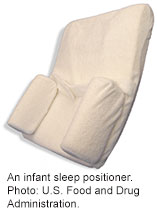
WEDNESDAY, Nov. 21 (HealthDay News) — Parents should not use commercially available “infant sleep positioners” unless they are prescribed by their pediatrician. The devices have been associated with suffocation deaths, U.S. health officials warn.
The U.S. Centers of Disease and Prevention released a report detailing one such case and including findings from the U.S. Consumer Product Safety Commission, which has documented 13 deaths linked to infant sleep positioners in a 13-year period.
“Infant sleep positioners pose a serious suffocation risk to babies,” U.S. Food and Drug Administration spokeswomen Michelle Bolek said.
“[The] FDA is not aware of any evidence showing that the benefits of infant sleep positioners outweigh the risk of suffocation and [the] FDA has never cleared an infant sleep positioner to prevent or reduce the risk of sudden infant death syndrome,” Bolek said.
In several of these deaths, infants were placed on their side with a sleep positioner in misguided attempts to prevent sudden infant death syndrome (SIDS), according to the report published in the Nov. 23 issue of the CDC’s Morbidity and Mortality Weekly Report.
Other deaths resulted when positioners were used to prevent reflux, keep the baby’s head elevated, prevent the baby from rolling over and prevent flattening of the baby’s skull.
These deaths occurred despite labeling on the device that cautioned: “Once your baby begins to move around during sleep, the sleep positioner should no longer be used,” or, “This product is to be used if your pediatrician has recommended side sleeping for your baby,” the report noted.
The devices have only a limited use, Bolek said. “Very few infants benefit from the use of infant sleep positioners,” she said.
“Using an infant sleep positioner would be at the discretion of a health care professional for a specific medical condition,” Bolek added. “For example, a baby with cerebral palsy who has difficulty swallowing may need a positioner to sleep. These babies are not likely to roll off the device because they do not move normally as a result of their disability.”
Despite their dangers, the FDA isn’t considering removing sleep positioners from the market, Bolek noted.
“[The] FDA believes we are taking the appropriate action at this time,” she said. “Using an infant sleep positioner would be at the discretion of a health care professional for a specific medical condition.”
According Bolek, the U.S. Consumer Product Safety Commission and FDA are warning parents and child care providers to:
- Stop using infant positioning devices. Using a device to hold an infant in a particular position is dangerous and unnecessary.
- Never put pillows, infant positioning devices, comforters or quilts under the baby or in the crib.
- Always place an infant on his or her back at night and during naptime.
Dr. Jose Rosa-Olivares, medical director of the Pediatric Care Center at Miami Children’s Hospital, warned against the use of infant sleep positioners.
“In 2011 the American Academy of Pediatrics said parents should avoid using these positioning devices,” Rosa-Olivares said. “There is no medical evidence that these devices offer any benefit.”
“Babies should always sleep on their back on a firm surface,” he said. “Parents shouldn’t add anything to the bedding area that can potentially cause suffocation. This includes pillows, stuffed animals, bolsters or comforters.”
Parents may mistakenly fear that babies placed on their back are in danger of vomiting or spitting up, which could block their airway and cause them to suffocate, Rosa-Olivares said. “The reality is there are automatic mechanisms in the body to prevent that. That’s not why babies die in their sleep. They die in their sleep because they suffocate — not because of spitting up or vomiting when they are sleeping on their backs.”
More information
For more on the dangers of sleep positioners, visit the U.S. Food and Drug Administration.

